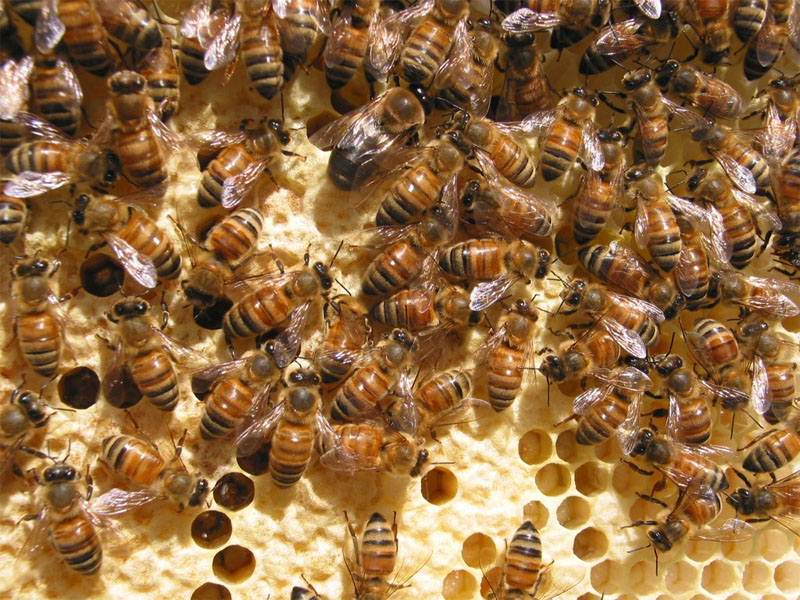mBio:蜜蜂体内发现一种致病植物病毒
中国农业科学院和美国合作,在蜜蜂体内发现一种通常感染植物的病毒病原体,这可能有助于解释蜜蜂数量下降的原因。相关文章发表于2014年1月21日的《mbio》杂志上。

mBio:蜜蜂体内发现一种致病植物病毒
研究作者、美国农业部农业研究局(ARS)的陈燕萍(Yan Ping Chen,音译)说:“对蜜蜂进行常规筛查寻找常见及罕见突变,我们偶然检测到了烟草环斑病毒(Tobacco Ringspot virus, TRSV),促使我们调查了这种植物感染病毒是否也可能引起了蜜蜂的全身感染。”
论文的第一作者、中国农业科学院副研究员李继莲(Ji Lian Li)说:“我们的研究结果提供了首个证据表明,接触病毒污染花粉的蜜蜂也会受到感染,并且感染在它们的身体内广泛存在。”
陈燕萍说:“我们已经知道当蜜蜂在花与花之间飞来飞去时可以传播TRSV,有可能将这种病毒从一棵植物传播到了另一棵植物。”
值得注意的是,大约5%的已知植物病毒通过花粉传播,因此有可能是一些宿主跳跃病毒源头。RNA病毒往往尤其的危险,因为它们缺乏在复制基因组中编辑删除错误的3'-5'校对功能。因此,像TRSV一类的病毒生成了大量具有不同感染特性的变异副本。
这样的高复制率所导致的一个后果就是,一些rna病毒群作为“准种”(quasispecies)而存在。这些遗传多样性资源,加上大群体规模,进一步推动RNA病毒适应新宿主施加给它们的新选择环境。“因此,RNA病毒有可能是新发和再发传染病的一个源头,”研究人员说。
这一毒性病毒鸡尾酒似乎与蜂群崩溃症候群(Colony Collapse Disorder,CCD),最早报道于2006年导致全美国所有蜂房突然破坏殆尽的一种神秘疾病有关。以色列急性麻痹病毒(IAPV)、急性蜜蜂麻痹病毒(ABPV)、慢性麻痹病毒(CPV)、蜜蜂克什米尔病毒(KBV)、蜜蜂卷翅病毒(DWV)、黑蜂王台病毒(BQCV)和囊状幼虫病病毒(SBV)是其他已知的蜜蜂病毒病致病原因。
当研究人员将蜂群分为“强”、“弱”两类时,发现在弱蜂群中TRSV和其他病毒更为常见。高水平多重病毒感染的蜂群在深秋开始衰弱,于二月之前死亡。相比之下,那些较少病毒攻击的蜂群则在整个寒冷的冬季存活下来。
研究人员也在大蜂螨(Varroa mites)的体内检测到了TRSV,大蜂螨是一种“吸血”寄生虫在它们吸食蜜蜂的血液时会在蜜蜂之间传播病毒。不过不同于蜜蜂,大蜂螨相关的TRSV仅局限于它们的胃盲囊,表明大蜂螨有可能促进了TRSV在蜂群内的水平传播,但自身却不会患病。感染蜂王产下受到感染的卵,让科学家们确信TRSV能够从蜂王母亲垂直传递给它的后代。
研究人员说:“TRSV和其他蜜蜂病毒日趋流行与宿主种群逐渐衰落有着密切的关系,由此支持了这一观点:病毒感染对群体生存造成了显著的负面影响。”她们呼吁要加强对潜在宿主跳跃事件的监控。
原文摘要:
Systemic Spread and Propagation of a Plant-Pathogenic Virus in European Honeybees, Apis mellifera
Ji Lian Li, R. Scott Cornman, Jay D. Evans, Jeffery S. Pettis,Yan Zhao, Charles Murphy, Wen Jun Peng, Jie Wu,Michele Hamilton, Humberto F. Boncristiani Jr., Liang Zhou,John Hammond, Yan Ping Chen
Emerging and reemerging diseases that result from pathogen host shifts are a threat to the health of humans and their domesticates. RNA viruses have extremely high mutation rates and thus represent a significant source of these infectious diseases. In the present study, we showed that a plant-pathogenic RNA virus, tobacco ringspot virus (TRSV), could replicate and produce virions in honeybees, Apis mellifera, resulting in infections that were found throughout the entire body. Additionally, we showed that TRSV-infected individuals were continually present in some monitored colonies. While intracellular life cycle, species-level genetic variation, and pathogenesis of the virus in honeybee hosts remain to be determined, the increasing prevalence of TRSV in conjunction with other bee viruses from spring toward winter in infected colonies was associated with gradual decline of host populations and winter colony collapse, suggesting the negative impact of the virus on colony survival. Furthermore, we showed that TRSV was also found in ectoparasitic Varroa mites that feed on bee hemolymph, but in those instances the virus was restricted to the gastric cecum of Varroamites, suggesting that Varroa mites may facilitate the spread of TRSV in bees but do not experience systemic invasion. Finally, our phylogenetic analysis revealed that TRSV isolates from bees, bee pollen, and Varroa mites clustered together, forming a monophyletic clade. The tree topology indicated that the TRSVs from arthropod hosts shared a common ancestor with those from plant hosts and subsequently evolved as a distinct lineage after transkingdom host alteration. This study represents a unique example of viruses with host ranges spanning both the plant and animal kingdoms.

